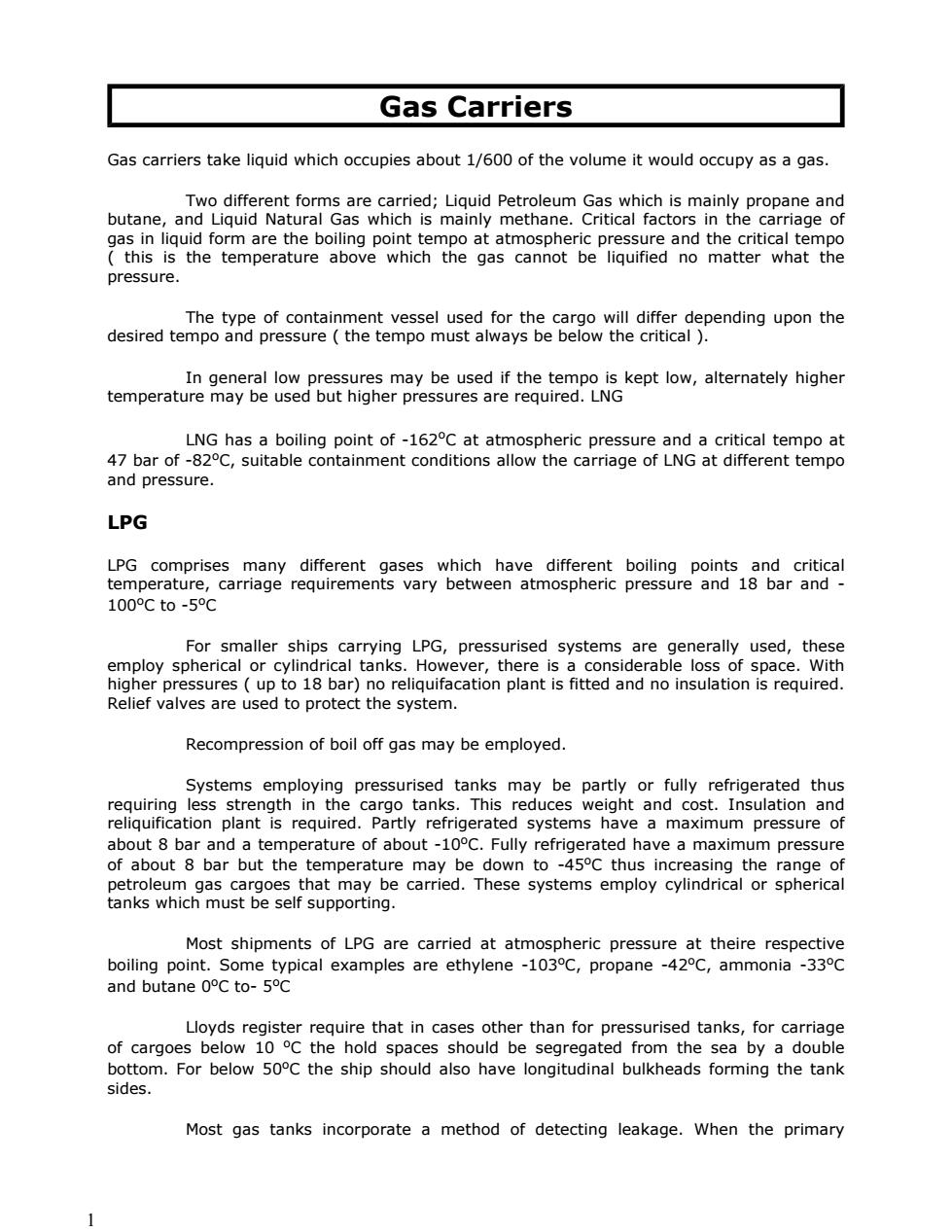
Gas Carriers Gas carriers take liquid which occupies about 1/600 of the volume it would occupy as a gas. Two different forms are carried;Liquid Petroleum Gas which is mainly propane and butane,and Liquid Natural Gas which is mainly methane.Critical factors in the carriage of temperature above no matte In general low pressures may be used if the tempo is kept low,alternately higher temperature may be used but higher pressures are required.LNG LNG has a boiling point of-162C at atmospheric pressure and a critical tempo at 47 bar of-82C,suitable containment conditions allow the carriage of LNG at different tempo and pressure. LPG speanu5agegenenggyteheanrfnemerte5g8e29a8Rram 100°Cto-5°0 ror smaler shipa carying pressunsed systems are deneraly used,vith uifacation plant is fitted and no insulation is require Relief valves are used to protect the system. Recompression of boil off gas may be employed. Systems employing pressurised tanks may be partly or fully refrigerated thus Partly re ms ha Fully refrig maximum pressure 0 have a maximum pressure thus increa Most shipments of LPG are carried at atmospheric pressure at theire respective boiling point.Some typical examples are ethylene-103C,propane-42C,ammonia-33C and butane 0C to-59C Lloyds register require that in cases other than for pressurised tanks,for carriage of cargoes below 10 C the hold spaces should be segregated from the sea by a double bottom.For below 50C the ship should also have longitudinal bulkheads forming the tank sides. Most gas tanks incorporate a method of detecting leakage.When the primary 1
Gas Carriers Gas carriers take liquid which occupies about 1/600 of the volume it would occupy as a gas. Two different forms are carried; Liquid Petroleum Gas which is mainly propane and butane, and Liquid Natural Gas which is mainly methane. Critical factors in the carriage of gas in liquid form are the boiling point tempo at atmospheric pressure and the critical tempo ( this is the temperature above which the gas cannot be liquified no matter what the pressure. The type of containment vessel used for the cargo will differ depending upon the desired tempo and pressure ( the tempo must always be below the critical ). In general low pressures may be used if the tempo is kept low, alternately higher temperature may be used but higher pressures are required. LNG LNG has a boiling point of -162oC at atmospheric pressure and a critical tempo at 47 bar of -82oC, suitable containment conditions allow the carriage of LNG at different tempo and pressure. LPG LPG comprises many different gases which have different boiling points and critical temperature, carriage requirements vary between atmospheric pressure and 18 bar and - 100oC to -5oC For smaller ships carrying LPG, pressurised systems are generally used, these employ spherical or cylindrical tanks. However, there is a considerable loss of space. With higher pressures ( up to 18 bar) no reliquifacation plant is fitted and no insulation is required. Relief valves are used to protect the system. Recompression of boil off gas may be employed. Systems employing pressurised tanks may be partly or fully refrigerated thus requiring less strength in the cargo tanks. This reduces weight and cost. Insulation and reliquification plant is required. Partly refrigerated systems have a maximum pressure of about 8 bar and a temperature of about -10oC. Fully refrigerated have a maximum pressure of about 8 bar but the temperature may be down to -45oC thus increasing the range of petroleum gas cargoes that may be carried. These systems employ cylindrical or spherical tanks which must be self supporting. Most shipments of LPG are carried at atmospheric pressure at theire respective boiling point. Some typical examples are ethylene -103oC, propane -42oC, ammonia -33oC and butane 0oC to- 5oC Lloyds register require that in cases other than for pressurised tanks, for carriage of cargoes below 10 oC the hold spaces should be segregated from the sea by a double bottom. For below 50oC the ship should also have longitudinal bulkheads forming the tank sides. Most gas tanks incorporate a method of detecting leakage. When the primary 1
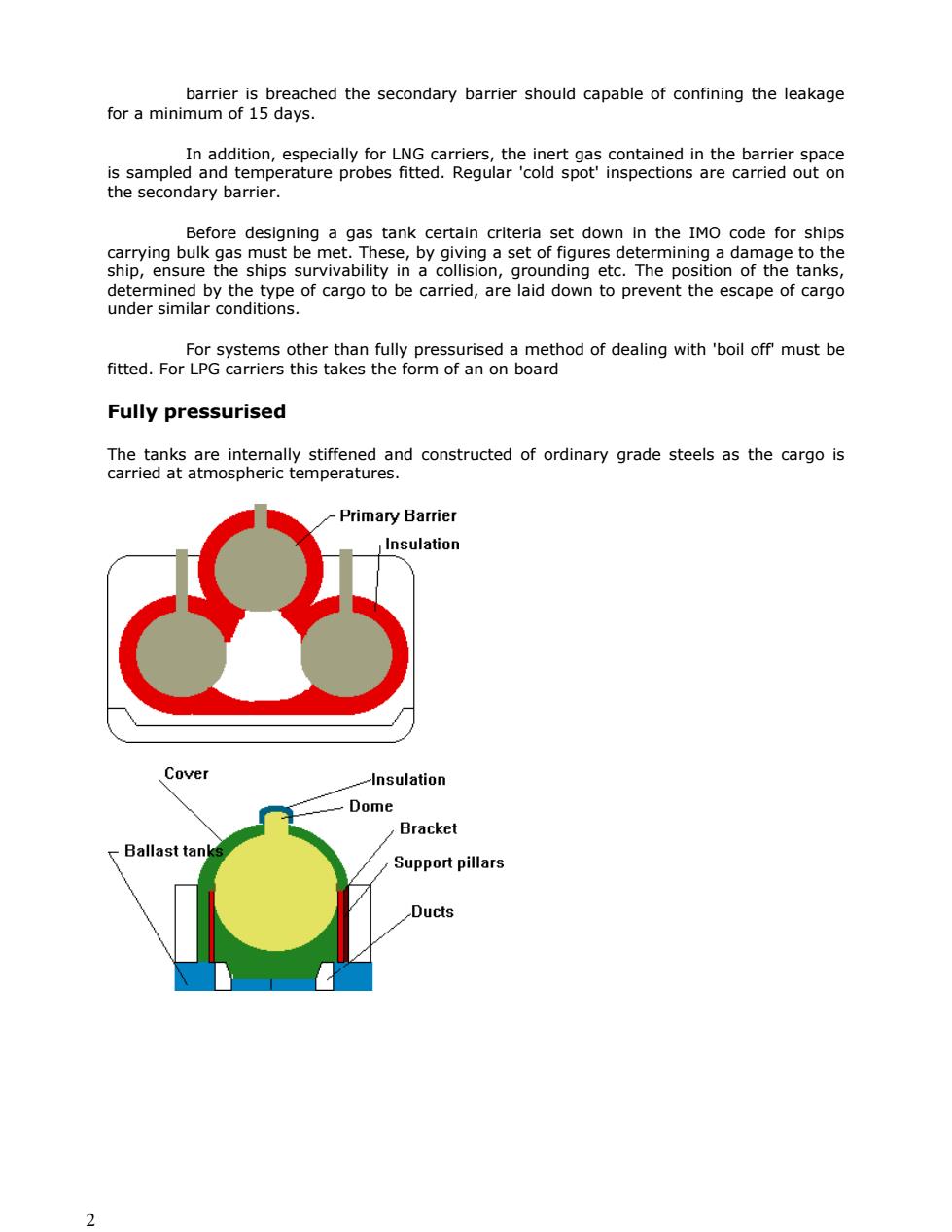
barrier is breached the secondary barrier should capable of confining the leakage for a minimum of 15 days. d by the type of cargo to be carried,are laid down to prevent the escape of cargo Fo of ar oar Fully pressurised Primary Barrier Insulation Cover -Insulation Dome Bracket Ballast ta Support pillars Ducts 2
barrier is breached the secondary barrier should capable of confining the leakage for a minimum of 15 days. In addition, especially for LNG carriers, the inert gas contained in the barrier space is sampled and temperature probes fitted. Regular 'cold spot' inspections are carried out on the secondary barrier. Before designing a gas tank certain criteria set down in the IMO code for ships carrying bulk gas must be met. These, by giving a set of figures determining a damage to the ship, ensure the ships survivability in a collision, grounding etc. The position of the tanks, determined by the type of cargo to be carried, are laid down to prevent the escape of cargo under similar conditions. For systems other than fully pressurised a method of dealing with 'boil off' must be fitted. For LPG carriers this takes the form of an on board Fully pressurised The tanks are internally stiffened and constructed of ordinary grade steels as the cargo is carried at atmospheric temperatures. 2
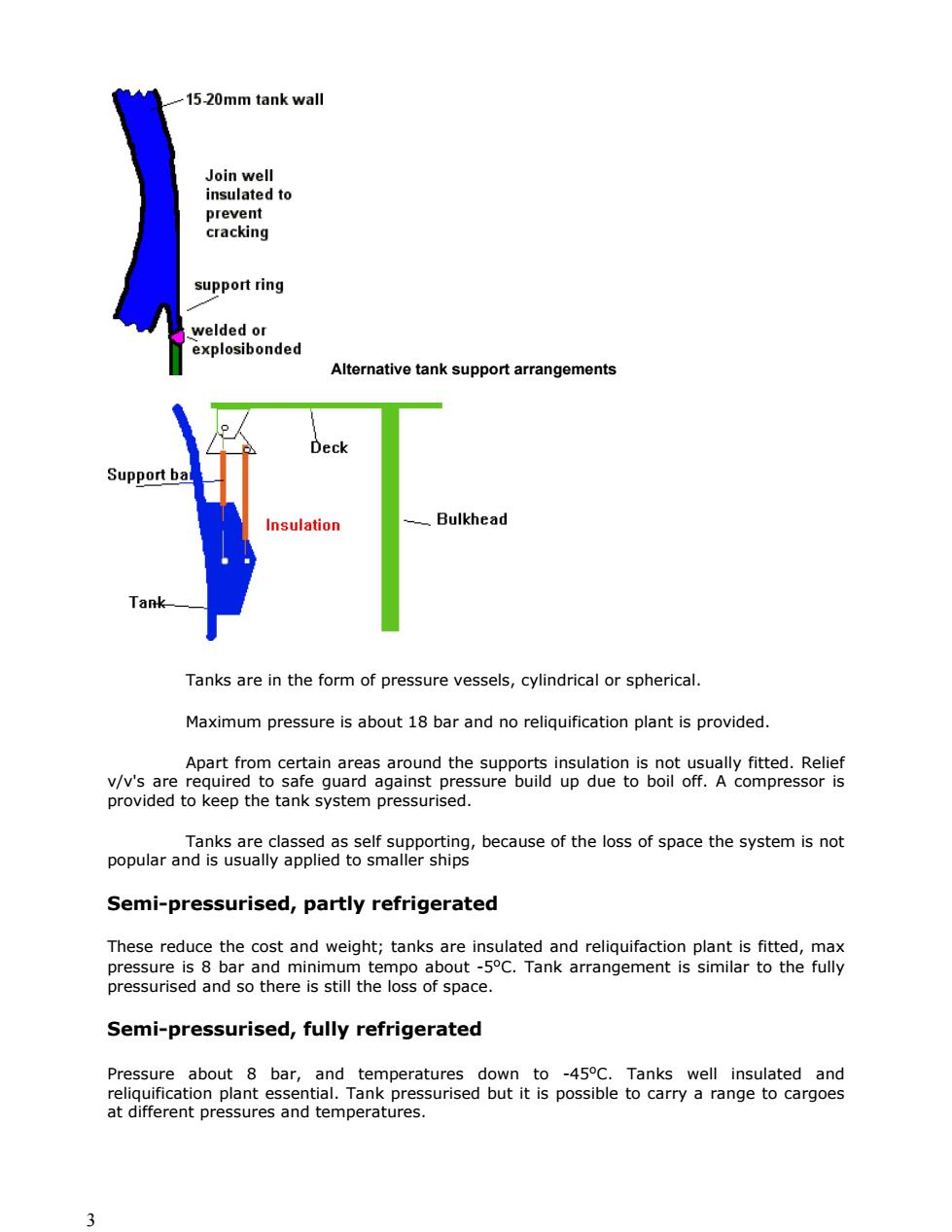
15.20mm tank wall cracking support ring elded or explosibonded Alternative tank support arrangements Insulation Tanks are in the form of pressure vessels,cylindrical or spherical. Maximum pressure is about 18 bar and no reliquification plant is provided. A compressor is Tanks are classed as self supporting,because of the loss of space the system is not popular and is usually applied to smaller ships Semi-pressurised,partly refrigerated pressure is 8 bar and r m ter Semi-pressurised,fully refrigerated to-45C. Tanks well insulated and eratures. t it is possi to carry a range to cargoes
Alternative tank support arrangements Tanks are in the form of pressure vessels, cylindrical or spherical. Maximum pressure is about 18 bar and no reliquification plant is provided. Apart from certain areas around the supports insulation is not usually fitted. Relief v/v's are required to safe guard against pressure build up due to boil off. A compressor is provided to keep the tank system pressurised. Tanks are classed as self supporting, because of the loss of space the system is not popular and is usually applied to smaller ships Semi-pressurised, partly refrigerated These reduce the cost and weight; tanks are insulated and reliquifaction plant is fitted, max pressure is 8 bar and minimum tempo about -5oC. Tank arrangement is similar to the fully pressurised and so there is still the loss of space. Semi-pressurised, fully refrigerated Pressure about 8 bar, and temperatures down to -45oC. Tanks well insulated and reliquification plant essential. Tank pressurised but it is possible to carry a range to cargoes at different pressures and temperatures. 3
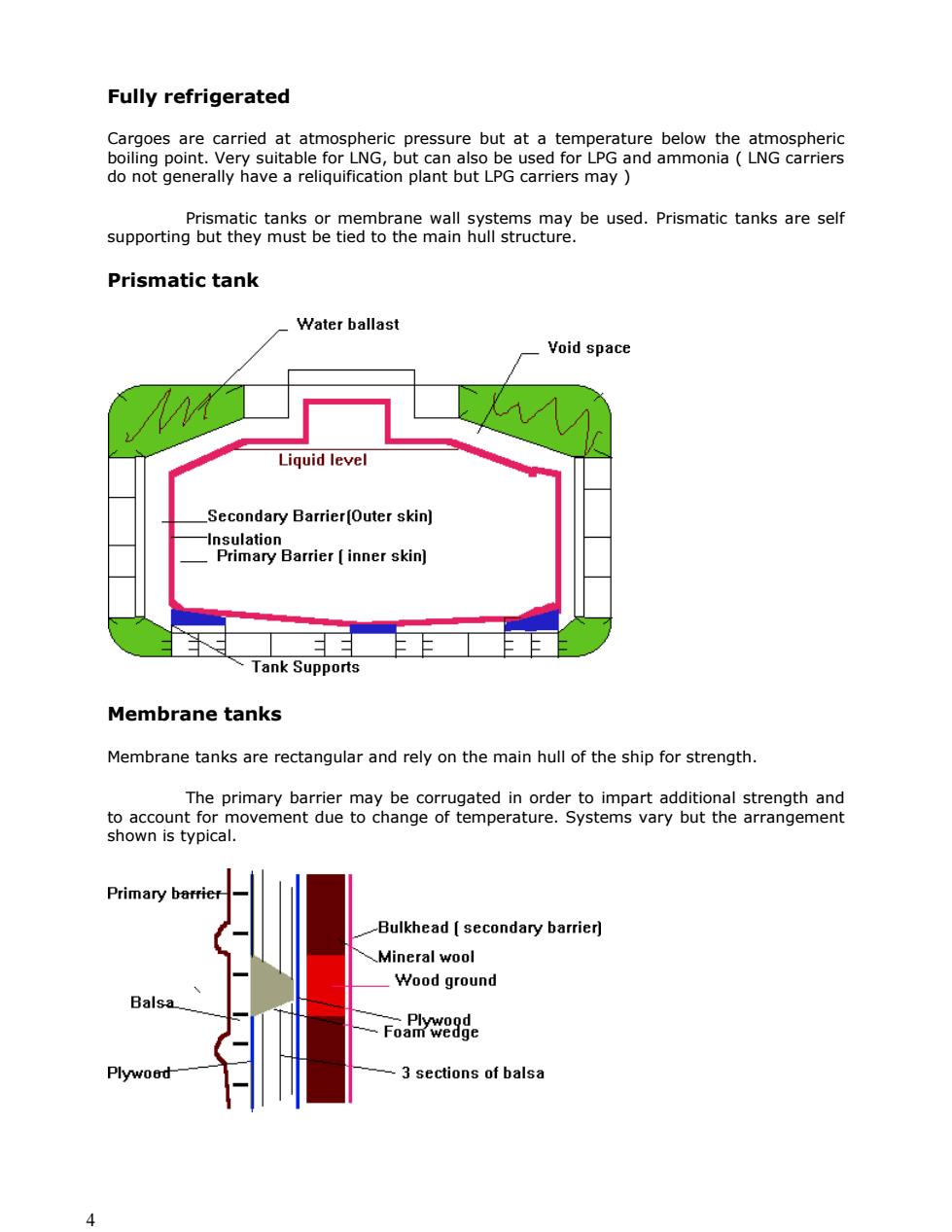
Fully refrigerated Cargoes are carried at atmospheric pressure but at a temperature below the atmospheric boiling point.Very suitable for LNG,but can also be used for LPG and ammonia LNG carriers do not generally have a reliquification plant but LPG carriers may Prismatic tanks or membrane wall systems may be used.Prismatic tanks are self supporting but they must be tied to the main hull structure. Prismatic tank Water ballast Void space A Liquid level Secondary Barrier(Outer skin) heihipBaierinnerskin Tank Supports Membrane tanks Membrane tanks are rectangular and rely on the main hull of the ship for strength shown is typical Bulkhead secondary barrier) Mineral wool Wood ground Foam wegge 3 sections of balsa 4
Fully refrigerated Cargoes are carried at atmospheric pressure but at a temperature below the atmospheric boiling point. Very suitable for LNG, but can also be used for LPG and ammonia ( LNG carriers do not generally have a reliquification plant but LPG carriers may ) Prismatic tanks or membrane wall systems may be used. Prismatic tanks are self supporting but they must be tied to the main hull structure. Prismatic tank Membrane tanks Membrane tanks are rectangular and rely on the main hull of the ship for strength. The primary barrier may be corrugated in order to impart additional strength and to account for movement due to change of temperature. Systems vary but the arrangement shown is typical. 4
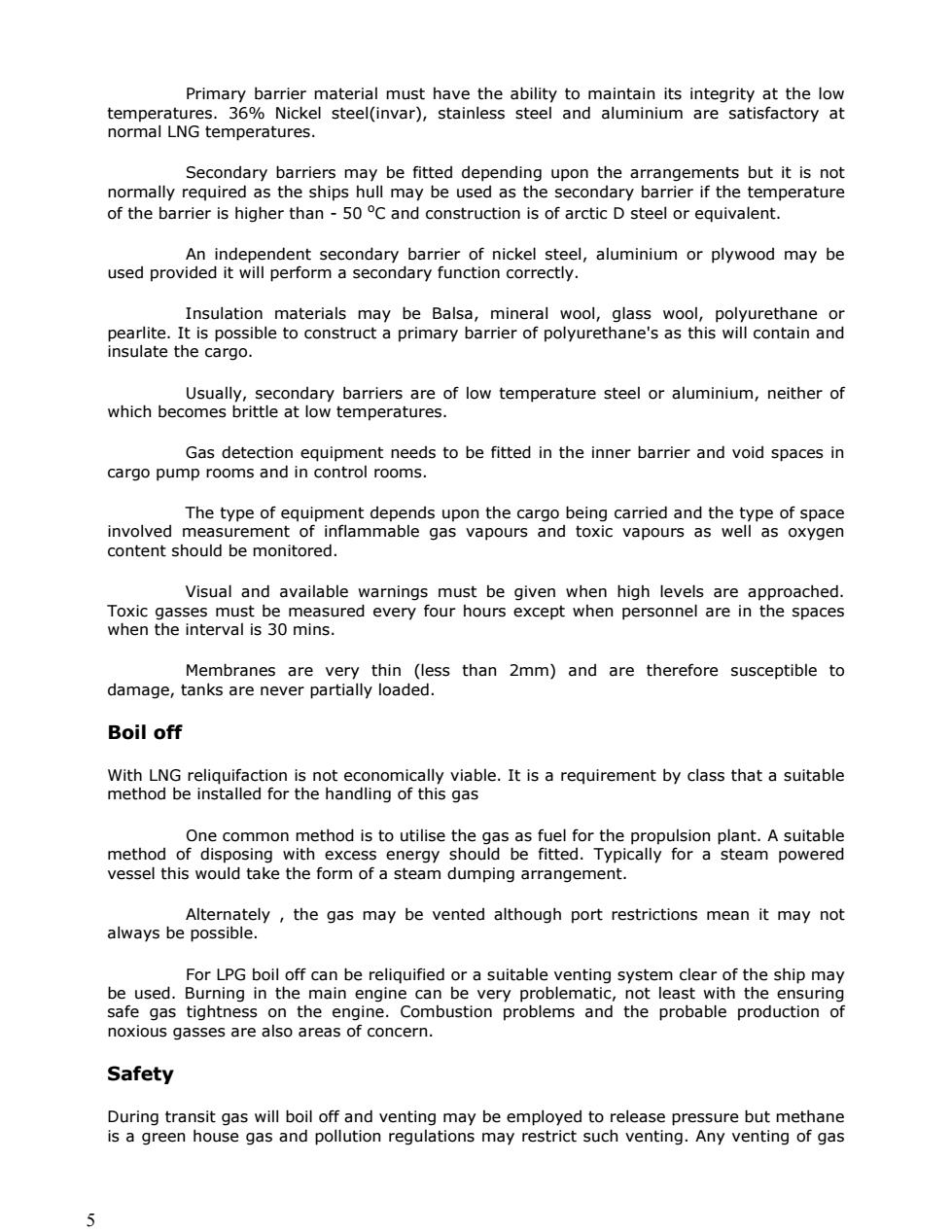
Primary barrier material must have the ability to maintain its integrity at the low temperaNces 36 Nickel steel(invar)stainless steel and aluminum are satistactor mperature s may be fitted depending ents but it is not normally required as the ships hull may be used as the secondary barrier if the temperature of the barrier is higher than-50 C and construction is of arctic D steel or equivalent. An independent secondary barrier of nickel steel,aluminium or plywood may be used provided it will perform a secondary function correctly. Insulation materials may be Balsa,mineral wool,glass wool,polyurethane or es possible to construct a primary barrer of polyurethane's as this will contain and cargo Gas detection equipment needs to be fitted in the inner barrier and void spaces in cargo pump rooms and in control rooms. The type of equipment depends upon the cargo being carried and the type of space nflammable gas vapours and toxic vapours as well as oxygen Visual and av ilable ached R器ervmi Membranes are very thin (less than 2mm)and are therefore susceptible to damage,tanks are never partially loaded. Boil off With LNG reliquifaction is not economically viable.It is a requirement by class that a suitable method be installed for the handling of this gas e common be Alternately,the gas may be vented although port restrictions mean it may not always be possible. For LPG boil off can be reliquified or a suitable venting system clear of the ship may safe gasss on the engine.Combustion problems and on the Safety
Primary barrier material must have the ability to maintain its integrity at the low temperatures. 36% Nickel steel(invar), stainless steel and aluminium are satisfactory at normal LNG temperatures. Secondary barriers may be fitted depending upon the arrangements but it is not normally required as the ships hull may be used as the secondary barrier if the temperature of the barrier is higher than - 50 oC and construction is of arctic D steel or equivalent. An independent secondary barrier of nickel steel, aluminium or plywood may be used provided it will perform a secondary function correctly. Insulation materials may be Balsa, mineral wool, glass wool, polyurethane or pearlite. It is possible to construct a primary barrier of polyurethane's as this will contain and insulate the cargo. Usually, secondary barriers are of low temperature steel or aluminium, neither of which becomes brittle at low temperatures. Gas detection equipment needs to be fitted in the inner barrier and void spaces in cargo pump rooms and in control rooms. The type of equipment depends upon the cargo being carried and the type of space involved measurement of inflammable gas vapours and toxic vapours as well as oxygen content should be monitored. Visual and available warnings must be given when high levels are approached. Toxic gasses must be measured every four hours except when personnel are in the spaces when the interval is 30 mins. Membranes are very thin (less than 2mm) and are therefore susceptible to damage, tanks are never partially loaded. Boil off With LNG reliquifaction is not economically viable. It is a requirement by class that a suitable method be installed for the handling of this gas One common method is to utilise the gas as fuel for the propulsion plant. A suitable method of disposing with excess energy should be fitted. Typically for a steam powered vessel this would take the form of a steam dumping arrangement. Alternately , the gas may be vented although port restrictions mean it may not always be possible. For LPG boil off can be reliquified or a suitable venting system clear of the ship may be used. Burning in the main engine can be very problematic, not least with the ensuring safe gas tightness on the engine. Combustion problems and the probable production of noxious gasses are also areas of concern. Safety During transit gas will boil off and venting may be employed to release pressure but methane is a green house gas and pollution regulations may restrict such venting. Any venting of gas 5